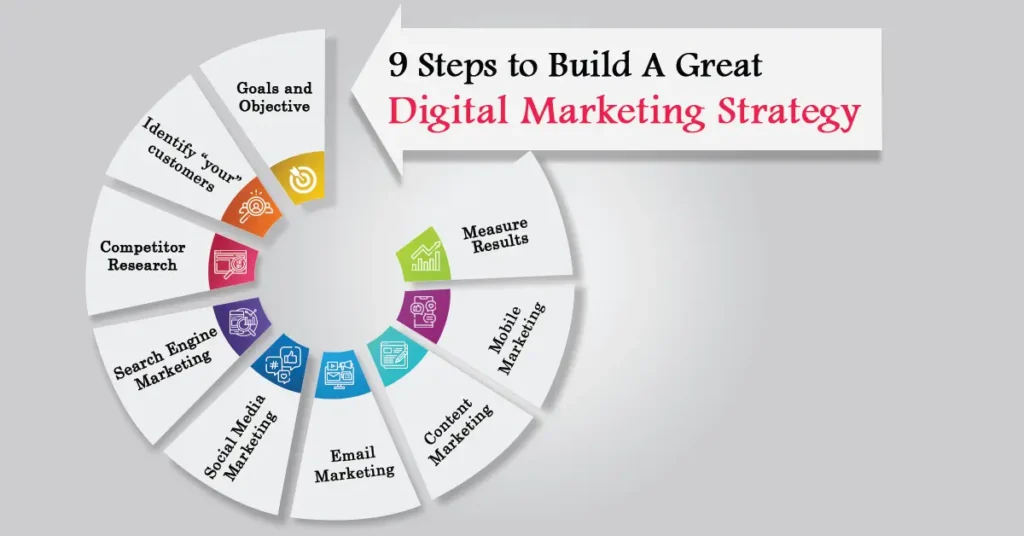As a Principal Systems Architect and Digital Strategy Expert, I’ve seen firsthand how a well-crafted digital strategy can transform businesses. It’s not just about having an online presence; it’s about architecting intelligent interactions that drive measurable results. Building a successful digital strategy campaign is a multi-faceted endeavor, requiring precision, foresight, and a keen understanding of both technology and human behavior.
Here are the nine crucial steps to building a successful digital strategy campaign, designed to anticipate needs, self-optimize, and deliver profound business impact.
1. Goals and Objective: The North Star of Your Strategy
Every impactful digital strategy begins with clearly defined goals and objectives. Without a precise destination, your journey will lack direction. Are you aiming for increased brand awareness, lead generation, higher conversion rates, or improved customer retention? Your objectives should be SMART: Specific, Measurable, Achievable, Relevant, and Time-bound. This foundational step dictates every subsequent decision, ensuring that all efforts align with a singular, strategic purpose. Think of this as defining the desired outcome of your systems architecture – what problem are you solving, and what success metrics will you track?
2. Identify “Your” Customers: Knowing Your Digital Persona
In the digital realm, understanding your audience is paramount. This goes beyond basic demographics; it involves deep dives into psychographics, online behavior, pain points, aspirations, and preferred communication channels. Developing detailed buyer personas allows you to tailor your messaging, content, and platform choices to resonate authentically with those you aim to serve. If you’re building a system, you wouldn’t just think about features; you’d think about the end-user’s workflow and needs. Similarly, a digital strategy must be customer-centric to succeed.
3. Competitor Research: Learning from the Landscape
No strategy operates in a vacuum. Thorough competitor research offers invaluable insights into what’s working (and what’s not) in your industry. Analyze their digital footprint: their website, social media presence, content strategy, advertising campaigns, and SEO performance. Identify their strengths, weaknesses, opportunities, and threats (SWOT). This intelligence allows you to differentiate your approach, uncover untapped niches, and position your brand for maximum impact. It’s akin to reverse-engineering a high-performance system – understanding existing solutions helps you innovate beyond them.
4. Search Engine Marketing (SEM): Dominating the Digital Discovery
SEM is the bedrock of online visibility, encompassing both Search Engine Optimization (SEO) and paid search advertising (PPC). SEO optimizes your digital assets to rank organically in search engine results, driving qualified, unpaid traffic. This involves meticulous keyword research, technical SEO, on-page optimization, and strategic link building. PPC, on the other hand, provides immediate visibility through targeted ads, offering control over ad spend and audience targeting. A robust SEM strategy ensures your brand is found exactly when potential customers are searching for solutions you provide.
5. Social Media Marketing: Cultivating Connection and Community
Social media is more than just a broadcast channel; it’s a dynamic ecosystem for building brand loyalty, fostering engagement, and driving traffic. A successful social media strategy identifies the most relevant platforms for your audience, defines content pillars, establishes a consistent posting schedule, and actively engages with the community. From authentic storytelling to targeted advertising, social media marketing amplifies your message and humanizes your brand, creating a vibrant digital dialogue.
6. Email Marketing: Nurturing Relationships, Driving Conversions
In an age of fleeting attention, email marketing remains one of the most powerful and cost-effective channels for direct communication. It allows for personalized messaging, segmented campaigns, and automated workflows that nurture leads through the sales funnel. From welcome sequences and promotional offers to newsletters and re-engagement campaigns, email marketing builds direct relationships, reinforces brand authority, and consistently drives conversions by delivering value straight to the inbox.
7. Content Marketing: The Engine of Engagement and Authority
Content is king, queen, and the entire royal court in digital strategy. A compelling content marketing strategy involves creating and distributing valuable, relevant, and consistent content to attract and retain a clearly defined audience. This can include blog posts, articles, videos, infographics, podcasts, whitepapers, and more. High-quality content not only addresses audience pain points but also establishes your brand as an industry thought leader, fueling SEO, social media, and email marketing efforts.
8. Mobile Marketing: Optimizing for the On-the-Go User
With the majority of internet users accessing content via mobile devices, a mobile-first approach is non-negotiable. This means ensuring your website is responsive, emails are mobile-friendly, and all digital assets provide a seamless experience on smartphones and tablets. Mobile marketing also encompasses SMS campaigns, mobile apps, and location-based services. For a Principal Systems Architect focused on mobile-first automation workflows, this step is intuitive – if it doesn’t run lean, smart, and fast on mobile, it’s not truly optimized.
9. Measure Results: Iterating Towards Perfection
The digital landscape is constantly evolving, and a static strategy is a failing one. The final, yet continuous, step is to rigorously measure the performance of your campaigns. Utilize analytics tools to track key performance indicators (KPIs) against your initial goals. Analyze traffic sources, conversion rates, engagement metrics, customer acquisition costs, and return on investment (ROI). This data-driven feedback loop is critical for identifying what’s working, optimizing underperforming elements, and making informed adjustments to your strategy for continuous improvement. It’s the self-optimization loop for your digital ecosystem.
Building a successful digital strategy campaign is not a linear checklist but a dynamic, interconnected process. Each step influences the others, forming a cohesive system designed to drive your business forward. By meticulously planning, executing, and optimizing each phase, you don’t just follow trends; you set them, turning your digital presence into a market dominator.
Share this:
- Click to share on Facebook (Opens in new window) Facebook
- Click to share on X (Opens in new window) X
- Click to share on LinkedIn (Opens in new window) LinkedIn
- Click to share on Reddit (Opens in new window) Reddit
- Click to share on Pinterest (Opens in new window) Pinterest
- Click to share on Pocket (Opens in new window) Pocket
- Click to share on WhatsApp (Opens in new window) WhatsApp
- Click to email a link to a friend (Opens in new window) Email



